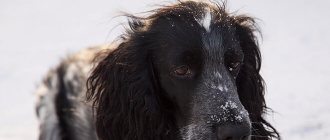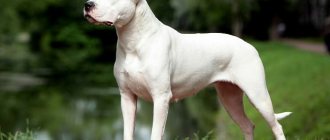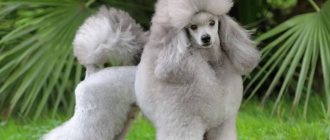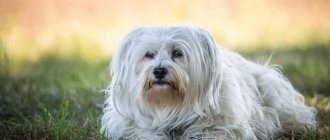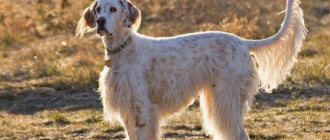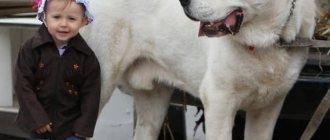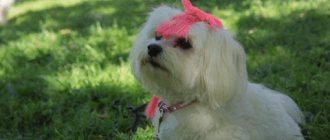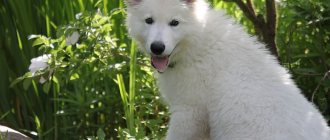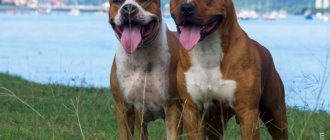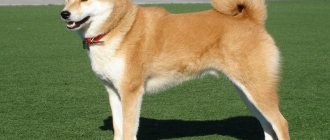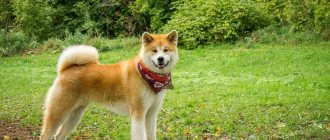Hachiko's story, known throughout the world, attracted attention to Japanese dog breeds. Although there are relatively few varieties bred on the islands, they are all attractive in appearance and character, intelligence and ability to quickly absorb knowledge. The small Japanese group has a number of specific features common to all its representatives. The development of the breeds is due to the prolonged isolation of the Land of the Rising Sun. The minimum contact with the outside world led to the fact that Japanese dogs did not interbreed with other varieties.
Japanese dogs attract with intelligence and beauty
Sanshu
The new breed is not yet two centuries old, and although it resembles an Akita, it is believed that its ancestors were Chow Chows. Sanshu has an unusual structure of the skull and muzzle, a strong neck, developed muscles and powerful paws. An adult dog weighs about 25 kg, and in good conditions it is a real long-liver - up to 17 years.
Photo: zooclub.ru
Small dog breeds: names and photos (catalog)
Tosa Inu
Tosa Inu are very different from typical Japanese breeds, but nevertheless they were bred in the Land of the Rising Sun. This is a fighting mastiff - strong, huge, hardy and brave. You need to raise such a dog from the first months so that it does not grow up aggressive. You shouldn't have a Tosa Inu in a home with small children, but it will become a faithful guardian and a good companion.
Photo: bestzooo.ru
American Akita
The American Akita was bred from the Akita Inu. The first representatives from Japan were brought to the United States after World War II, where they quickly became popular.
To get a new breed of dogs, Americans crossed Akitas with German shepherds and mastiffs. The resulting breed was called the Great Japanese Dog. It differs from its eastern relatives in its massive build, variety of colors and more flexible character.
Otherwise the breeds are similar. American Akitas are as freedom-loving and independent as their Japanese relatives. Care and maintenance are also the same: a large Japanese dog is kept in an apartment or outside the city, washed several times a year, and combed every week.
Kai
The breed was bred in the mountains, almost completely isolated from the flat part of the region, so it best preserved its original features. Kai is an active hunting dog that needs company and socialization. She is gregarious, gets along well with children and other animals, and is not at all afraid of heat and cold.
Photo: avito.ru
What is the Nippo organization?
Japanese dogs are under the patronage of the “Society for the Protection of Aboriginal Dog Breeds” (abbreviated name - Nippo), created by dog enthusiasts in 1928 with the aim of preserving indigenous breeds that were the result of hybridization with the local - now extinct - subspecies of wolves.
This measure was very timely, since by that time purebred indigenous dogs had been practically replaced by animals of European breeds imported into the country at the end of the 19th century, after the end of Japan’s self-isolation policy.
The Nippo Association Register currently lists six breeds that have been awarded the status of National Treasure of Japan:
- kai;
- kisyu;
- Akita Inu;
- Shiba;
- Shikoku;
- Hokkaido.
Shiba Inu
Not too large, but strong and hardy, the Shiba Inu has gained popularity in Japan as a hunting dog. These are brave, self-sufficient and strong-willed animals that need the same owner-leader. Adult Shiba Inus are a bit like foxes in their skull structure. They are suspicious of strangers and have a highly developed hunting instinct.
Photo: funart.pro
Medium dog breeds: names and photos (catalog)
Sakhalin Husky
The Japanese call Sakhalin or Gilyak Laikas karafuto-ken. Initially, the breed was native to the Amur region and the Sakhalin region. But in the 30s of the twentieth century, they were deliberately exterminated from the house. At the same time, the dogs were brought to Japan, where they worked on their awakening.
Sakhalin Huskies are considered an endangered breed. Work is still underway to restore and increase the number.
Sakhalin residents are sled dogs. They were also used to attract bears and sea animals. They are smart, brave and very resilient. In terms of working qualities, they are superior to Siberian Huskies, Malamutes and other breeds.
The breed went down in history thanks to an extraordinary event. In 1958, Japanese researchers had to leave 15 Sakhalin huskies in Antarctica. Scientists hoped to restore them soon, but due to deteriorating weather, they were able to return only a year later. Surprisingly, people found two surviving dogs. In honor of them and the dead dogs, a monument was erected in Japan and two films were made: “Antarctica” and the American remake of “White Captivity”.
Shikoku
An ancient Japanese breed in origin is the closest relative of the Shiba Inu. Adult dogs grow over 50 cm at the withers, with short, dense hair that requires almost no grooming. Shikoku can be kept in an apartment, but then they need to be walked regularly, because by nature they are active and agile hunters.
Photo: funart.pro
Kishu
Like all Japanese dog breeds, the Kishu received its name from its habitat - the Kishu Principality (Kii Peninsula) and is recognized as a national treasure.
According to legend, these dogs descended from a wolf: a rescued she-wolf gave the hunter a wolf cub, which became the progenitor of the breed.
The Kishu breed is rare, even for Japan: it lives in remote, isolated areas of the country. Every year, the country's national canine organization registers an average of 700-900 puppies of this breed.
Kishu is a medium-sized Japanese breed, has pointed, erect ears and is white, red or wolf in color.
Typical dimensions for males: height 49–55 centimeters, weight up to 25 kilograms, for females - height 46–52 centimeters, weight up to 20 kilograms.
Life expectancy is 14–15 years.
When caring for the coat, you will need to comb your pet after each walk and wipe the coat with a damp towel instead of bathing.
Kishu is not characterized by violent manifestations of feelings towards its owner; it has a restrained disposition and requires respectful treatment. As for children, jokes with annoying pats and stroking with pussy will not work: the game will be stopped immediately.
But still, the dog is patient with many life circumstances, hardy, friendly and welcoming.
Kishu retains its protective qualities and this explains its distrust of strangers.
The dog is difficult to train due to its self-confident nature and excellent hunting instinct. The owner will need to show not only a tactful and respectful attitude towards the dog, but also extraordinary perseverance to achieve results.
Kisya can be kept both in a city apartment and a private house, but with the condition of providing her with long, active walks.
The appearance of the Kishu is similar to another medium-sized Japanese dog, the Shikoku.
Hokkaido
The second name of this breed is Ainu, and in appearance it resembles a Spitz. These are very ancient, rare and valuable dogs, ideally suited for mountainous terrain and difficult living conditions. She was not specially bred, which means that the main features of her appearance and character were formed under the influence of natural selection. Hokkaido are very brave, decisive and have good sense of direction in new terrain or unfamiliar situations.
Photo: funart.pro
The most beautiful dog breeds: names and photos (catalog)
Care and maintenance
Caring for a clean and unpretentious chin is absolutely simple. It is advisable, of course, to take him for a walk three times a day, but it is permissible to limit himself to one walk, having accustomed the dog to a home litter box. In bad weather, you can walk with your dog, holding it in your arms, or dress your pet in a waterproof overall. During hot weather, it is advisable to walk your dog in the shade, as overheating may cause the dog to suffocate. For walks with your chin, choose not a collar, but a chest harness - a kind of harness, since its neck is quite delicate. Please note that these dogs, being without a leash, can easily climb the first height they come across, for example a children's slide, so you need to make sure that the little pet does not fall and injure itself.
Japanese Chin with Yorkshire
Caring for the coat of the Japanese Chin is also not difficult. He does not need model hairstyles, and the haircut is only hygienic, requiring only the removal of overgrown hairs. It would be good to brush your pet daily; in any case, this procedure should be performed at least twice a week, accustoming the dog to it from puppyhood.
Cinchona is bathed as needed, but not more than once every two weeks. Paws and ears are washed as they become dirty. For bathing, use zoo shampoos, which, in addition to the cleaning effect, also have antimicrobial and antiparasitic properties. After washing with shampoo, treat the dog's coat with conditioner - this will make it fluff up and smell nice. After the procedure, the Japanese Chin must be dried so that it does not catch a cold. You can use a towel or hairdryer.
As an alternative to bathing, you can use a dry method of cleaning the animal's fur using a special powder. Some owners use talc or baby powder for this procedure. The product should be carefully rubbed into the pet’s fur, making sure that some of it gets on his skin. After powdering, thoroughly comb the animal's fur until the powder disappears completely. This method allows you to effectively clean the coat of dirt and dead hair.
Grooming of the Japanese Chin
The claws of Japanese Chins grow very quickly, while they bend and split, which causes discomfort to the dog. They should be trimmed using a nail clipper as they grow, usually at least once a month. The dog will be especially grateful to the owner for this cosmetic procedure.
The diet of chins should be high in calories. These dogs don’t eat much, but they move very actively, even when living in an apartment. The diet should include foods containing sufficient amounts of protein and calcium. For animals of this breed, the following products are preferred and must be alternated: turkey meat, chicken, lean beef, boiled liver, tripe, kidneys, sea fish (no more than once a week), boiled yolk (two to three times a week). Periodically you need to give rice, boiled vegetables, raw pitted fruits.
The finished food must be premium or holistic.
It is important not to overfeed your chin, because it quickly gains excess weight, and this negatively affects its health. It is advisable that the gentle Japanese Chin be periodically examined by a veterinarian for preventative purposes. For animals of advanced age, veterinary examinations are recommended to be carried out regularly.
For animals of advanced age, veterinary examinations are recommended to be carried out regularly.
It is advisable that the gentle Japanese Chin be periodically examined by a veterinarian for preventative purposes. For older animals, veterinary examinations are recommended regularly.
Japanese Chin after shower
Japanese Terrier
Another breed that is not quite typical and rare for Japan is the hunting terrier. They are not too big and cannot stand the cold, so they do well in the apartment and for walks in the park. Adult dogs are very empathetic, easily pick up on their owner’s mood, and also have impeccable hearing and sense of smell.
Photo: usobaki.com
Kai-ken
This breed has several names, but the names most often used to designate it are “Kai-ken” or brindle dog. The calling card of the breed is its unusual coat color, which in part actually resembles the skin of a tiger. Like other native breeds, brindle dogs were raised in isolated geographical conditions, which allowed them to successfully maintain the purity of the breed. Since ancient times, Kai-kens have been used to hunt various wild animals, such as wild boars, deer and even bears.
Kai-Ken
The negative side of such isolation was the small number of livestock. The Kai-ken is considered a very rare dog even in Japan itself, where representatives of the breed are carefully protected. The reason for the sharp decline in the breed is the temporary indifference of the Japanese to indigenous dogs, associated with the importation of new European individuals back in the twentieth century.
Character traits
The character of dogs of the Kai-ken breed was formed inextricably linked with their main function - pursuit of prey and assumes the presence of the following traits:
friendliness. The hunter's habits do not prevent brindle dogs from showing their good nature. Kai-ken are open to adults and patient when playing with children. At the same time, it is not recommended to keep these dogs under the same roof as cats;
devotion to the owner. Like other hunting breeds, the Kai-ken literally lives for one person, to whom he gives most of his attention. However, brindle dogs develop such relationships only with those owners who do not allow themselves unnecessary things (screams, pressure and other methods of rough influence); activity
In the absence of hunting, it is very important for Kai-kens to be able to waste their energy reserves. Therefore, keeping such pets in an apartment in the city center is inappropriate
Brindle dogs are not intended for large capitals;
Best articles: Which ocean is the smallest in area and volume on the planet?
intelligence. Loyalty and intelligence are an excellent combination when training a pet, especially if the brindle dog trusts its owner in everything and follows his instructions with pleasure.
Health status
Tiger dogs, like many other native breeds, have strong immunity. The purity of the gene allowed Kai-ken dogs to protect themselves from predisposition to many diseases. Unfortunately, even such strong purebred dogs can have health problems.
The most common pathologies for brindle dogs are:
- hip dysplasia;
- elbow dysplasia;
- hyperthyroidism;
- retinal atrophy.
Representatives of the Kai-Ken breed are susceptible to various forms of dysplasia
With proper attention from a veterinarian, all these ailments can be avoided or at least their progression can be significantly slowed down.
Hin
The tiny toy breed, weighing about 3 kg, is one of the oldest breeds in Japan. Chins can live in absolutely any room, but are not at all adapted to the street. Such dogs are easy to train, but cannot tolerate boredom, so you will have to try to choose more interesting tasks.
Photo: krasivosti.pro
Did you like the post? Subscribe to our channel in Yandex.Zen, it really helps us in our development!
